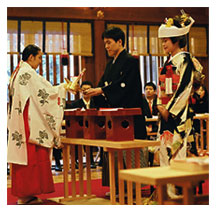
In modern day Japan, couples getting married have several kinds of wedding ceremony choices that they can choose from. The most traditional of the ceremonies, is the Shinto style wedding that roots from the traditional Shinto beliefs. Commonly held in a Shinto shrine, the traditional Japanese wedding usually is presided over by a Shinto priest. It is generally a very private and formal event that is attended by the closest family members. Instead of having a bridesmaid or a best man, an older married couple, known as nakoudo or matchmaker, attends the ceremony. The role of matchmakers comes from the historical Bushi warrior's view of marriage as diplomatic and political strategies to maintain peace. They also symbolize the idea of a stable wedding. Today, as the popularity of the traditional wedding ceremony declines, so does the presence of the nakoudos at weddings.
 Typically, at a Shinto wedding ceremony, the bride is painted white from head to toe as a symbol of her purity, and as a way to declare her maidenhood to the gods. She will commonly wear a pure white hood, known as a wataboshi. Sometimes, bride will wear a tsunokakushi which symbols the hiding of the bride’s horns o jealousy and is a symbol of her submission to her husband to become a gentle and obedient wife. The bride generally wears an expensive kimono that is typical in white. The groom is dressed in a black and white kimono ensemble that consists of four layers.
Typically, at a Shinto wedding ceremony, the bride is painted white from head to toe as a symbol of her purity, and as a way to declare her maidenhood to the gods. She will commonly wear a pure white hood, known as a wataboshi. Sometimes, bride will wear a tsunokakushi which symbols the hiding of the bride’s horns o jealousy and is a symbol of her submission to her husband to become a gentle and obedient wife. The bride generally wears an expensive kimono that is typical in white. The groom is dressed in a black and white kimono ensemble that consists of four layers.
The couple is first purified by the Shinto priest, a ceremony which is witnessed by family members. The couple then exchanges their vows. This is followed by the san-san-kudo ceremony.
San-san-kudo Ceremony
Literally translated as “three-three-nine-times”, the san-san-kudo ceremony is the ritualized sake drinking ceremony in a wedding. It is one of the oldest of wedding ceremonies in Japan. Originating between 1600 and 1868, it is still commonly practiced today.
During the san-san-kudo, a small amount of sake is consumed by both the bride and groom as a symbol of binding.
 A specific cup known as a sakazuki is used to contain the sake. It is only used to drink sake and is used for no other beverages. Shaped like a shallow dipping bowl, the sakazuki comes in a set of three with three cups of varying sizes: a small, medium and large cup.
A specific cup known as a sakazuki is used to contain the sake. It is only used to drink sake and is used for no other beverages. Shaped like a shallow dipping bowl, the sakazuki comes in a set of three with three cups of varying sizes: a small, medium and large cup.
During the ceremony, they are stacked one atop another with the largest on the bottom and the smallest on the top. The smallest cup represents heaven, the medium cup represents earth, and the largest cup represents mankind. The bride and groom each take turns to sip three times out of the three cups. By the end, each of them will have sipped three times from each of the three cups, totaling nine times from which the name of the ceremony comes. As three and nine are lucky numbers in Japan, this ceremony is also seen as an auspicious ceremony.
Kekkon Hiroen
 Following the traditional Shinto ceremony, many couples today choose to have a wedding reception where more friends, co-workers and relatives are invited to attend to share the couple’s joy.
Following the traditional Shinto ceremony, many couples today choose to have a wedding reception where more friends, co-workers and relatives are invited to attend to share the couple’s joy.
Known as kekkon hiroen, the wedding reception is commonly at hotel ballroom, or rented spaces and follow a strict program. Today, to maximize time and space, the kekkon hiroen will last exactly two hours.
The reception opens with a dramatic entrance of the bride and groom, often to impressive effects of smoke, lighting display and stage lighting. In the opening entrance, the bride and groom often enter with the nakoudos, matchmakers. The master of ceremony will congratulate the couple and their family members and announce the nakoudos.
The bride and groom will then makes speeches. Following which, a series of Western-style traditions, including: cake cutting and the couple’s first dance as husband and wife, will take place.
Often during the kekkon hiroen, the bride will change into several gowns. The groom, as well, gets the chance to change his outfit during the reception.
 The kanpai, or toasting segment of the program will follow, during which friends, relatives will make speeches and toast the newly weds. The mood relaxes during this segment as guests drink and the atmosphere becomes more casual. The kanpai, or toasting segment of the program will follow, during which friends, relatives will make speeches and toast the newly weds. The mood relaxes during this segment as guests drink and the atmosphere becomes more casual.
After the final change of their costumes, the bride and groom will then go around lighting the candle on each of the guests’ tables. They will finally return to their table and light a long candle known as the memorial candle.
The remaining time is a celebration with dances, short speeches, as well as a flower presentation by the newly weds to their parents as a symbol of their gratitude to them for raising them to become the people that they are.
Customs
Bride, groom, family members, as well as friends and other guests all have to observe specific customs when attending a Japanese wedding ceremony. Specifically, when one receives a wedding invitation card, one is expected to return the enclosed card to inform the couple of one’s attendance.
All guests attending the wedding reception are also expected to give cash as gift to the couple. This cash gift’s amount is determined by the relationship of the guest to the couple. Typically, the closer the relationship, the higher the gift amount. Sometimes a fixed gift amount is indicated on the invitation card. The cash gift is enclosed within a gift envelope known as shugi-bukuro and the name of the guest is written on the front. When arriving at the reception, the envelope is handed over to the person at the reception desk, and the guest signs in at the guest book.
Contemporary Practices
In Japan today, couples have the choice to choose between traditional Shinto weddings and Western style wedding ceremonies. Even though only about 3% of the population is Christians, the younger generation is inclined towards holding a Western style wedding because it is cheaper than the high cost of renting a Shinto shrine and the silk kimono wedding suits. As Western wedding tradition become more accepted and popular, many young couples see it as a welcoming way to celebrate the union of two people as well as two families.
|


 Typically, at a Shinto wedding ceremony, the bride is painted white from head to toe as a symbol of her purity, and as a way to declare her maidenhood to the gods. She will commonly wear a pure white hood, known as a wataboshi. Sometimes, bride will wear a tsunokakushi which symbols the hiding of the bride’s horns o jealousy and is a symbol of her submission to her husband to become a gentle and obedient wife. The bride generally wears an expensive kimono that is typical in white. The groom is dressed in a black and white kimono ensemble that consists of four layers.
Typically, at a Shinto wedding ceremony, the bride is painted white from head to toe as a symbol of her purity, and as a way to declare her maidenhood to the gods. She will commonly wear a pure white hood, known as a wataboshi. Sometimes, bride will wear a tsunokakushi which symbols the hiding of the bride’s horns o jealousy and is a symbol of her submission to her husband to become a gentle and obedient wife. The bride generally wears an expensive kimono that is typical in white. The groom is dressed in a black and white kimono ensemble that consists of four layers.  A specific
A specific  Following the traditional Shinto ceremony, many couples today choose to have a wedding reception where more friends, co-workers and relatives are invited to attend to share the couple’s joy.
Following the traditional Shinto ceremony, many couples today choose to have a wedding reception where more friends, co-workers and relatives are invited to attend to share the couple’s joy.  The kanpai, or toasting segment of the program will follow, during which friends, relatives will make speeches and toast the newly weds. The mood relaxes during this segment as guests drink and the atmosphere becomes more casual.
The kanpai, or toasting segment of the program will follow, during which friends, relatives will make speeches and toast the newly weds. The mood relaxes during this segment as guests drink and the atmosphere becomes more casual.